Latifa Echakhch & David Maljković, ‘Morgenlied’
Exhibition, Apr. 01 – May 27, 2012
Kunsthalle Basel, Switzerland
Back
Exhibition, Apr. 01 – May 27, 2012
Kunsthalle Basel, Switzerland
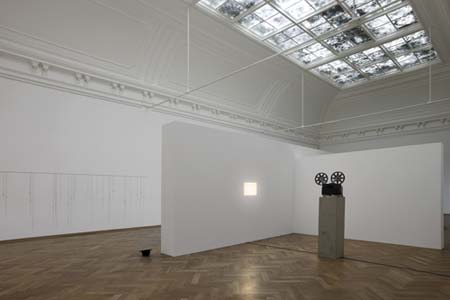
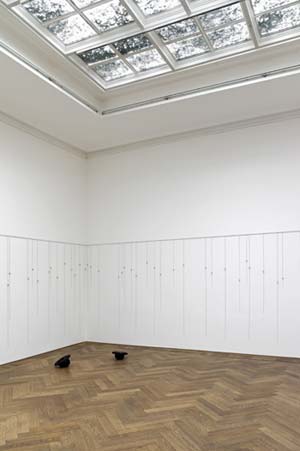
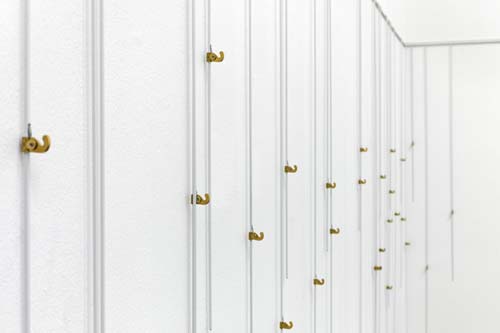
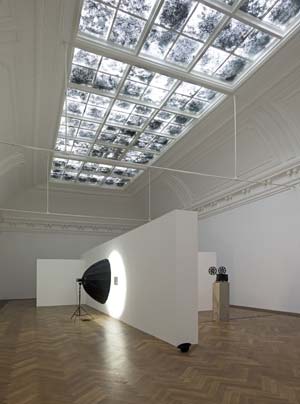
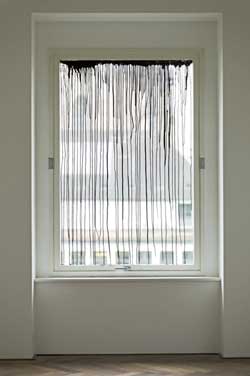

Morgenlied (Morning Song), an exhibition by Latifa Echakhch and David Maljković. The show came into being as a result of the artists’ shared, albeit differently motivated and articulated, interest in Modernist language of forms and the ideologies that used to support it.
Sharing a similar poetic sensibility, Latifa Echakhch and David Maljković named their exhibition after the title of a poem by Johann Wolfgang von Goethe from 1773. The architect Johann Jakob Stehlin used the initial lines of Künstlers Morgenlied (Artist’s Morning Song) in 1868 as the motto for his competition design for the construction of the Kunsthalle Basel. The first lines of the poem are “Der Tempel ist euch aufgebaut | Ihr hohen Musen all“ (The temple is built for you | All you high Muses). They describe the imagined future role of the Kunsthalle Basel – that of a temple dedicated to the arts. The architecture of the Kunsthalle’s main space, the “Oberlichtsaal”, with its neoclassical details and monumental skylight, is typical for the 19th century and may be read as a belated symbolic embodiment of the idea of the Enlightenment. While considering the historic architecture of the Kunsthalle, Latifa Echakhch and David Maljković have produced works that engage with the space and radically transform its expression.
Latifa Echakhch was born in El Khansa, Morocco in 1974 and today lives in Martigny in Switzerland. Her works, ranging from site-specific installations to videos, performances and sculptures using found objects, investigate the phenomena of cultural transfer and the accompanying disintegration and reconstitution of displaced identity. Echakhch uses culturally stereotyped artefacts that relate to specific contexts of use and production, such as flagpoles, Moroccan tea glasses, carpets, and materials such as couscous, Indian ink or clay bricks, modifying the connotations these objects carry. Shifting between the poles of foreignness and familiarity, the objects and materials are recontextualised in unexpected configurations and assume new meanings.
In her installation at the Kunsthalle Basel, another recurrent topic of Echakhch’s artistic work comes to the fore: her concern with marking the surface. This new site-specific work consists of a monumental painting executed in black ink on the skylight of the exhibition space. The black ink drops on the glass produce a play of light and shadow in the space. The painting covers over 80 square metres distributed on the 96 fields of the skylight. Contained within the existing grid, it respects the historic architecture and is set in careful dialogue with the building, but on the other hand it is clearly recognisable as a contemporary intervention. The main feature of the historical space, the skylight, is highlighted in its grandeur, but at the same time its original function, to let light in to evenly fill the space, is radically compromised. With its imposing height and oak-wood parquet floor, the “Oberlichtsaal” was designed in 1869 to accommodate the so-called “Petersburg hanging” of paintings and it can be thus considered a swan song of the 19th century bourgeois culture, associated with the Academy and Salon exhibitions. With the advent of the neutral “white cube” gallery space in the 20th century, this temple-like room has become a splendid obsolescence.
Latifa Echakhch uses the skylight as her canvas. Her paint is Indian ink, a traditional writing and drawing material invented in ancient China. The title of this work is Enluminure (2012). It refers to light and the notion of enlightenment as much as to the traditional art of illuminating manuscripts. However, in stark contrast to illuminating, Latifa Echakhch’ painting is carried out in black only. Instead of a figurative painting or abstract ornament, the artist has spilled and dripped the ink onto the glass, a procedure reminiscent of Jackson Pollock’s practice when creating his abstract expressionist paintings.
Another work by Latifa Echakhch on view, chapeau d’encre (2012), consists of six black hats turned upside down and strewn across the floor, as if blown off of someone’s head. These are filled halfway to the brim with what seems to be black ink. A material connoting writing, be it personal letters or romantic poetry, the ink-in-the-hat seems to allude to a wider metaphor for human thought – expressions such as “dark thoughts” come to mind, or the lines from Paul Celan’s Todesfuge (Fugue of Death, 1948): “Black milk of daybreak, we drink it at nightfall | we drink it at noon in the morning we drink it at night.” The liquid is in fact only a thin layer of ink, poured and dried onto layers of solidified resin. The work, impenetrable and modestly scaled, mirrors the black drops obscuring the surface of the skylight above it,
The installation on the walls carries the title Morgenlied (2012) – which also provides the title to the entire exhibition. The work displays a standard modern picture hanging system,
whereupon instead of hanging paintings, Echakhch uses the wires and hooks to produce an abstract linear composition on the wall, similar to a score for a song. Through the double absence of visible paintings and audible music in the installation, Echakhch relies on the evocative power of the form of the notation systems itself.
Images from top to bottom:
Latifa Echakhch, Morgenlied, 2012
steel, brass (pre-fabricated hanging system for paintings)
Courtesy the artist, kamel mennour, Paris and kaufmann repetto, Milan
Latifa Echakhch, Chapeau d’encre, 2012
hats, resin, Indian ink
Courtesy the artist, kamel mennour, Paris and kaufmann repetto, Milan
Latifa Echakhch, Enluminure, 2012
Indian ink, 1600 × 500 cm and 350 × 290 cm
Courtesy the artist, kamel mennour, Paris and kaufmann repetto, Milan
Latifa Echakhch, Enluminure, 2012
Indian ink, 200 × 130 cm
Courtesy the artist, kamel mennour, Paris and kaufmann repetto, Milan
David Maljković, Temporary Projections, 2011
2 paintings, soft box, 2 × 33 × 41 cm and ø 180 cm
Courtesy the artist and Annet Gelink Gallery, Amsterdam
Latifa Echakhch, Enluminure, 2012
Indian ink, 1600 × 500 cm and 350 × 290 cm
Courtesy the artist, kamel mennour, Paris and kaufmann repetto, Milan
Latifa Echakhch, Chapeau d’encre, 2012
hats, resin, Indian ink
Courtesy the artist, kamel mennour, Paris and kaufmann repetto, Milan
David Maljković, Temporary Projections, 2011
16 mm-projector
Courtesy the artist and Metro Pictures, New York
Photo: Serge Hasenböhler